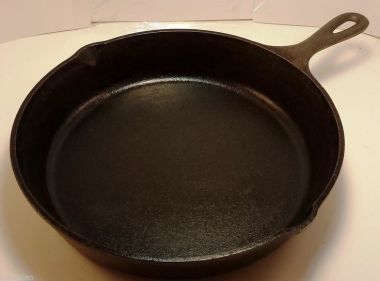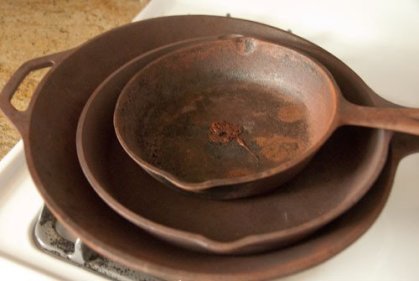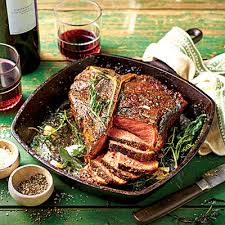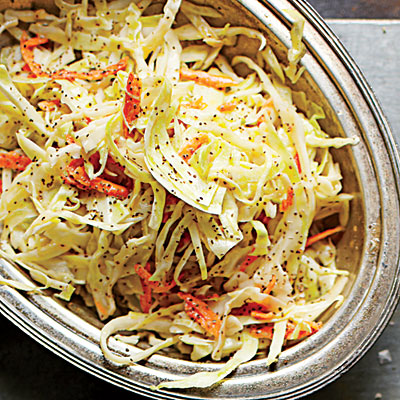Cast In Iron

I don’t want to beat this all to death, but I am always on the look-out for old cast iron pots and pans. You can often find them at places like the Minuteman Antiques Mall on Rt 3 just east of Culpeper. They have hundreds of stalls filled with country stuff- it is where I fond that bizarre blue corner hutch for the farm, but they have tons of junk. I have a sneaking suspicion that is where all my assorted crap is going to wind up,
The vendors know what they have, so some the pans can be a little pricey, particularly if they are disused or rusty. I think you might have better luck in the more downscale yard-sales, but you have to look and that is the fun to it all.

This is a nice example of something that might show up at a yard sale, and probably narrowly missed being collected for scrap back in World War Two. It is not hard to bring them back to better than new and ready for stick-free cooking.
There is no lack of tips and tutorials for seasoning cast iron, but very few of them actually explain the science behind the process. We are all about science here at The Daily. I would lead you through the conceptual and theoretical basis for how it all works. I could use terms like “polymerization” and “drying oil,” the use of which can help you choose the best oil for creating a hard, smooth, impermeable non-stick surface on your Lodge (or other antique maker’s) cast iron cookware.
Foodie Blogger Sheryl Canter has an in-depth post about the science behind seasoning cast iron, a subject she researched after being dissatisfied by the rather haphazard advice (like mine) she found around the web. The key is understanding polymerization, the process by which fat molecules join together form new, longer molecules, which create the hard, smooth surface of a well-seasoned pan.
But even if a pan is seasoned carefully, its surface can still be soft and prone to scratching. This is where the concept of a “drying oil” comes in. Drying oils like linseed oil are used by woodworkers because they form a tough, protective layer; but please don’t use it- it will make you blind or something.
An edible oil produced from the flaxseed plant is a drying oil that can serve the same purpose in the kitchen.
Canter has detailed instructions for using flaxseed oil to create a strong, smooth and long-lasting seasoning, whether you have “a new pan or an imperfectly-seasoned skillet that you want to strip and season fresh.”
http://sherylcanter.com/wordpress/2010/01/a-science-based-technique-for-seasoning-cast-iron/
Sheryl has put a lot of thought into her article, but I think she is overthinking things. If I start to get a little crusty build up on the glossy black surface of my cast iron, I pour in some extra virgin olive oil- Bertoli is the brand on the jug I am working on now- and heat it on the stove to the smoking point. If your smoke detector goes off, you have overheated. Turn off the gas, wipe off excess oil. Done.
I just leave my eight-inch Lodge skillet with the iron top right on the stove, since it is in use with nearly every meal.
The Dutch Oven is up on top of the hutch at the moment, but after describing the shredded short-rib with garden veggies and habanero peppers the other day, a pal asked about another recipe that incorporated all the advantages of cast iron cooking, and I told him I would oblige.
I wish I could say I thought this up, but I didn’t. You can find it in the October issue of Southern Living, a wonderful magazine that I used to subscribe to but got lost in all the moves. There are some teachable moments in this recipe that go against some of the grilling philosophy we all carry based on our upbringing. Thinking it through, I think this might be the best way to cook a thick, juicy bone-in steak restaurant-style without smoking up the house.
Use your Weber-brand grill to heat the cast-iron skillet; at high heat. Southern Living claims the skillet surface area promotes a “more assertive flavor and better sear than grill grates, yielding a steak with the proper steakhouse crust.” This involves the grill, and in Virginia, I am still going to be cooking outside until Christmas.
Here is the way you do Cowboy Steak:


Ingredients
Kosher salt and freshly ground black pepper
1 (1 1/2- to 2-lb.) bone-in rib-eye or porterhouse steak (about 2 inches thick)
1 tablespoon vegetable oil
3 tablespoons butter
8 fresh herb sprigs (such as thyme, rosemary, and oregano)
3 garlic cloves, peeled and smashed
Preparation
Preheat Weber grill to 400° to 450° (high) heat. Forget that last drunken barbeque that ran down the amount of propane in the tank. Thank god you got a backup. Lug it up from the barn, replace. Now fire it up and eat a 12-inch cast-iron skillet on grill, covered with grill lid, 15 minutes. Sprinkle salt and pepper generously over steak.
Add oil to skillet. (Oil should smoke.) Using tongs, place steak in skillet, and cook on grill, without grill lid, 10 minutes or until dark brown and crusty. Turn steak on fatty edge in skillet, holding upright with tongs, and cook 2 minutes. Place steak, uncooked side down, in skillet.
Cook on grill, covered with grill lid, 8 to 10 minutes or to desired degree of doneness. (We recommend an internal temperature of 120° to 125° for medium-rare; temperature will rise as steak rests.)
Add butter, herbs, and garlic to side of skillet, and cook 2 to 3 minutes or until butter foams. Tilt skillet slightly, and spoon butter mixture over steak 20 times (being careful not to splatter). Transfer steak, herbs, and garlic to a platter; let stand for 5 to 10 minutes. Slice against the grain.
I could leave it at that, but so long as I am borrowing from the good folks at Southern Living. Pair up your steak with some most triumphant salad:
I personally like it with a side of South Carolina slaw:
 

I stole this recipe from Southern Living- June 2013 issue.
Ingredients
1/2 head thinly sliced cabbage (about 1 lb.)
1 cup grated carrot
1/2 cup apple cider vinegar
1/4 cup sugar (You can substitute Splenda, but why?)
1/4 cup vegetable oil
2 tablespoons Dijon mustard
2 teaspoons dry mustard
1 teaspoon celery seeds
1 teaspoon kosher salt
1/2 teaspoon freshly ground black pepper
Preparation
Place cabbage and carrot in a bowl. Whisk together vinegar, sugar, vegetable oil, Dijon mustard, dry mustard, celery seeds, kosher salt, and freshly ground black pepper in a saucepan until sugar dissolves; bring to a boil over medium-high heat. Pour over cabbage mixture; toss to coat. Serve immediately.
And what the hell- so long as we have the cast iron out anyway, how about some down-home cornbread to mop up those juices? Note: This recipe is adapted from Hoppin’ John’s Lowcountry Cooking by John Martin Taylor.

Ingredients
2 to 3 teaspoons bacon drippings or vegetable oil
2 cups buttermilk
1 large egg
1 3/4 cups white cornmeal
1 teaspoon baking powder
1 teaspoon baking soda
1 teaspoon salt
Butter
Preparation
Coat bottom and sides of a 10-inch cast-iron skillet with bacon drippings; heat in a 450° oven for 10 minutes. (I save the drippings from the Croftburn Farms thick-cut pepper bacon)
Whisk together buttermilk and egg. Add cornmeal, stirring well.
Stir in baking powder, baking soda, and salt. Pour batter into hot skillet.
Bake at 450° for 15 minutes.
Try it on the grill on indirect heat while doing the steak. Serve with butter.
Bon appetite, Ya’all.
Copyright @014 Vic Socotra
www.vicsocotra.com
Twitter: @jayare303
